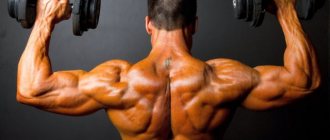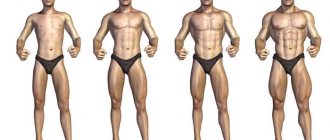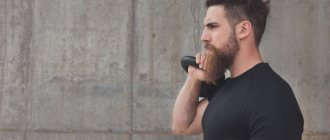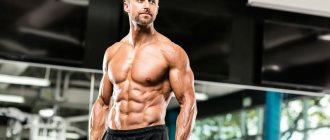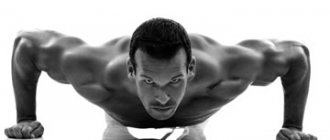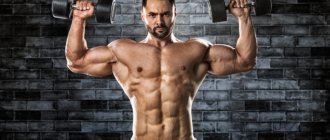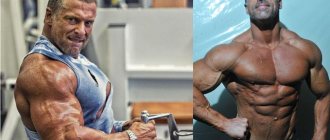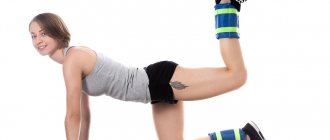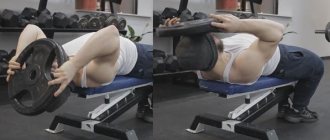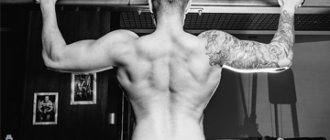Author of the article
Andrey Belozertsev
Drawing up programs for effective muscle mass gain.
Most often, when men plan to build muscle, they think about the appearance of their upper body.
A wide back, muscular, strong arms and six-pack abs have always been considered ideal for the stronger sex.
Before starting practical exercises, all professionals recommend familiarizing yourself with the theoretical part of the training in order to achieve good results in the shortest possible time and reduce the risk of injury.
In this article you will learn how to pump up your biceps and shoulders using the most effective exercises.
Anatomical structure
All muscles consist of protein fibers connected in bundles.
At the same time, the structure of the biceps and small muscles of the shoulder is very different. Let's take a closer look at these differences.
Shoulders
The shoulder is made up of a number of muscles:
- infraspinatus;
- supraspinatus;
- small round;
- large round;
- subscapular;
- deltoid.
The last muscle is the largest and reaches 80-90% of the mass of all other muscles surrounding the shoulder joint.
It is the deltoid muscle that gives the shoulder its rounded shape.
It consists of fibers of different textures and lengths, so it is sometimes divided into sections (bundles): posterior, middle and anterior.
Different structures determine different functions of the deltas, which unite into one main muscle of the shoulder.
Deltas perform the following functions:
- The front one flexes the shoulder and moves it “inward”, resulting in the raising of the arm.
- The middle one is responsible for abduction of the limb.
- The posterior one is responsible for the extension of the limb and its simultaneous rotation to the outside, as a result of which the raised humerus lowers.
The arms and shoulders have a complex structure, which is explained by the great involvement and mobility of the upper limbs.
Anatomy and functions of the triceps
The triceps runs along the back of the humerus and consists of three bundles, or heads, which is why this muscle is also called the triceps.
Lateral, long, medial heads of the triceps brachii muscle
The lateral (or external) triceps band extends from the shoulder to the elbow along the outside.
A long bun stretches from the shoulder blade along the inside of the shoulder.
And the medial bundle is located on the bone itself and is partially overlapped by other triceps bundles.
The triceps consists of three connected bundles
The triceps is responsible for moving the arm back and bringing it towards the body. The entire muscle is involved in extending the forearm.
Based on this, all exercises for working the triceps are in one way or another related to flexion and extension of the arm at the elbow.
Biceps exercises
With a barbell
These exercises are very popular among athletes of any level.
Most often, training for biceps with a barbell involves lifting the apparatus in a standing or sitting position.
Barbell exercises:
- Standing. Starting position: standing, back straight, shoulder blades pulled together, shoulders relaxed, arms along the body, elbows pressed to the sides. As you exhale, you need to bend your arms, straining your biceps, and lift the barbell to your shoulders. You can stay in this position for a second or two. As you inhale, you should return to the starting position.
- Sitting. The hands perform the same actions, only the projectile is placed on the knees. You need to sit on a bench with your feet hip-width apart. A powerful biceps curl is performed.
- Standing with a reverse grip. The back is straight, legs are shoulder-width apart. The hand lies on the bar, palm down. Exhale - bend your arms, inhale - return to the starting position.
Each exercise for pumping up arms with a barbell is performed in 2-3 sets of 10-15 repetitions.
On the horizontal bar
The horizontal bar is one of the most popular exercises because it is accessible to everyone, and with its help you can perform many exercises for the muscles of the entire upper body.
This once again confirms the rule: pumping up biceps at home is easy, the main thing is motivation.
The most effective exercises for the biceps muscle of the arm:
- Close grip pull-ups. Starting position: hanging on the bar, palms resting on the pipe with a narrow lower grip. As you exhale, bend your elbows and rise so that your head is above the bar. As you inhale, lower yourself down. Perform 3 sets of 14-16 repetitions.
- Pull-ups on a low bar. Starting position: hanging on a low bar, heels on the floor. As you exhale, you need to bend your elbows, while inhaling, straighten them. Do at least 2-3 sets of 15 reps.
These exercises are considered the most effective, but any pull-ups on the horizontal bar work well the arm muscles - biceps, triceps, deltoids - and chest.
With dumbbells
Dumbbells are rightfully considered the most convenient equipment for high-quality training of arm muscles.
The weight of this apparatus is very easy to adjust, so you can change the load gradually as you increase the volume of muscle mass.
If you want to build bigger biceps, home workouts may not be enough.
Therefore, it is recommended to perform some exercises in the gym, where there is a greater choice of equipment: there are many types of dumbbells available.
The most common techniques:
- Lifting with a turn. Starting position: standing, back straight, arms at your sides, knees slightly bent, palms with a neutral grip. As you exhale, you need to grasp the dumbbell and halfway through the movement, turn the back of your hand outward. While inhaling, return to the starting position. Do it alternately or simultaneously with both hands.
- "Hammer". Standing or sitting on a bench, take the projectile and, as you exhale, lift it to your shoulder. As you exhale, lower the dumbbell.
- One arm lift. Sitting with your body slightly tilted forward, place your elbow on your thigh. Perform concentrated curls when only the biceps are working. You can perform it with both hands at the same time if you find a support point (for example, the back of a chair).
Number of repetitions: 2-3 sets of 14-16 times.
Previously, we told you how to remove your butt.
With universal expander
The most common exercise with an expander that does not require additional loads is standing arm curls.
It is done this way:
- You need to stand in the middle of the tape, with your feet as the center of support. The elastic bands have good tension, the handles of the expander lie in the palms.
- Sit down a little and bend your elbows, raising your hands to the level of your collarbones.
- Stay at the highest point for two to three seconds and smoothly return to the starting position.
It is better to wear protective gloves to reduce the risk of injury to your palms.
Perform a minimum of 2-3 sets of 12-16 repetitions.
Without equipment
The most effective way to train biceps without equipment is push-ups. There are nuances to working out the biceps; this must be taken into account in order to train the muscles in a targeted manner.
Little tricks:
- While lying down, you need to shift your body weight slightly forward.
- Place your palms as close to each other as possible, press your elbows to your body.
- As you lower down, you should touch your chest to the floor to increase the load on your biceps.
You can do push-ups an unlimited number of times, but doing 3-4 sets of 15-20 repetitions is considered optimal.
In another article you can read about how to remove thighs.
Which muscles should you train in one day?
Which muscle groups can and should be trained together, and which ones are better divided into different days - this is one of the main questions that every novice athlete should study.
In modern gyms, when purchasing a membership, they give you personal training, during which the instructor will clearly explain the basics. Knowing the basic rules, you can train correctly and without injury. But it’s not always possible to buy a subscription to a large gym, and not all of them offer personal training. Beginners come to the gym and begin to indiscriminately grab equipment, hammering all the muscles in a row. There are also those who study every day for several hours. Usually this does not last long, because if you exercise without rest, you will soon get injured.
Professional athletes can train all day, every day. Pros take medications that promote rapid recovery, which helps avoid injury. Therefore, you don’t need to look at professionals, they spend half their lives in the gym and this is their main source of income. If you are a beginner, then you need to take the issue as seriously as possible before starting training.
Chest and triceps
There are main and auxiliary muscles. Accordingly, when the main muscle fails to perform a certain movement, the auxiliary muscle is activated. For example, when lifting a barbell while lying down, the main working muscle is the chest, but without the support of the triceps, the chest would not be able to fully perform this exercise. Of course, other muscles are also involved in the bench press, but the main load falls on the chest and triceps. These two muscles can be trained together on the same training day. So after the bench press, feel free to go train your triceps.
Back and biceps
The second muscle group that can be trained in one day is the back and biceps. Pull-up exercises are responsible for training the back, for which the work of the biceps is also important. Let's take the deadlift or pull-up as an example; in both exercises, the main muscles worked are the back muscles and biceps.
Legs and shoulders
We train the remaining muscles on the third day. These are the muscles of the legs and shoulders. Work these muscles to the fullest, because the next time you will return to your legs and shoulders only in a week. It is worth noting that the bench press also works the shoulders, but they do not receive enough stress to tire and grow. Choose exercises for which the main muscles involved are the shoulder muscles. To pump up your legs, be sure to do “barbell squats.”
You can train your abs every day. Abdominal muscles tend to recover quickly, because when performing abdominal exercises, you work only with your own weight, which completely eliminates the possibility of overtraining. By training your abdominal muscles every day, you won't be at risk for any injuries, like, for example, when performing deadlifts with a record weight.
We divided all the muscles into three days, which is optimal for beginner athletes. Many experts recommend training three days a week, working each muscle group and focusing only on the basics, before moving on to more serious workouts that require initial training.
advertising is not displayed
Shoulder workouts
Bars
The most effective exercise for pumping up your shoulders is dips. Also, this workout is aimed at working the triceps, biceps and chest.
The following steps must be followed:
- Starting position: support yourself on the uneven bars, straighten your arms, bend your knees.
- As you inhale, lower yourself down, bending your arms; the angle between your forearm and shoulder should be at least 90°.
- Return to the starting position slowly, while exhaling, holding for a few seconds at the top point.
You need to perform the exercise at least 2-3 sets of 20 times in order to thoroughly pump all the bundles of the deltoid muscle.
Horizontal bar
Pull-ups can help sculpt your shoulders, arms, chest, and even your upper back.
The most common types of exercises:
- Pull-ups with a narrow reverse grip.
- Pull-ups with a narrow straight grip.
- Head pull-ups.
- Medium grip with incomplete amplitude.
All these actions are performed according to a similar algorithm: the biceps are fully flexed, the head should be higher than the bar while lifting, the legs are bent so as not to sway.
As you exhale, you should rise, and as you inhale, you should lower. You need to perform at least three sets of 15 pull-ups.
Push ups
Training using your own body weight is no less effective.
The most difficult types of exercises that specifically pump up your shoulders:
- Reverse grip push-ups. They differ from the “classic” ones in the arrangement of the palms and elbows. The elbows should be pressed to the sides, and the fingers should be directed inward and “look” at each other.
- Handstand push-ups. The exercise is difficult, but incredibly effective. Leaning against the wall and standing on straight arms, you need to slowly lower yourself down.
Do at least 2-3 sets of 15 repetitions. If you cannot perform the exercise with full amplitude, it is better to do shallow push-ups, but do at least 20-30 repetitions.
Elastic tape
Exercises with an elastic band are very simple to perform and consist of the following: you need to stand on the center of the band, hold the handles of the apparatus in your palms.
Raise your arms straight to shoulder level. Do at least 2-3 sets of 15 repetitions.
Variations:
- Raising your arms to the sides while standing.
- Raising your arms to the sides while bent over.
- Raise your arms in front of you.
The back must be straight.
Dumbbells
You can lift dumbbells with any type of grip. The mass of the equipment should be large enough so that after ten lifts the muscles become noticeably tired.
There are a huge variety of exercises with dumbbells to pump up your shoulders.
Here are the main ones:
- Dumbbell shoulder press. While sitting on a bench, you need to hold the apparatus at shoulder level. Straightening your arms, lift the dumbbells up, hold for a couple of seconds and return to the starting position.
- Lifting to the sides. Standing straight, shoulder blades retracted, arms along the body. Raise the shells to the sides and slowly lower them.
- Bent over climb. Standing, legs bent, body straight. Raise your lowered arms to shoulder level, stay in this position for two to three seconds and return to the starting position.
Perform 2-3 approaches 15-20 times. The correct technique must be followed, otherwise other muscles will receive the load, not the deltoids. how to pump up biceps and shoulders
Barbell
Pumping your shoulders with a barbell is very effective. The main thing is to follow safety precautions: do not make sudden movements, take weights that are acceptable for your physical fitness, and protect your legs from falling equipment.
The most common shoulder exercises:
- Raising the barbell to the chin. It is considered the basis of any training. Starting position: standing, palms on the bar with a straight grip, very close - at a distance of 5-10 centimeters from each other. As you exhale, you should lift the barbell to your chin, hold for two seconds and lower the barbell while inhaling.
- Standing press. Starting position: standing, back straight, feet shoulder-width apart. Hold the barbell at chest level with an overhand grip, then lift it high above your head, hold for a few seconds, and lower the barbell.
Each exercise must be done at least 10-15 times in two approaches.
Weight
The most common shoulder exercise is the kettlebell snatch.
The execution technique is as follows:
- Start. Starting position – standing, feet shoulder-width apart. The weight stands on the floor, the handle is in such a way that it is convenient to quickly grab it. The palm is placed with an overhand grip. Your knees should be bent and your torso should be slightly tilted. The free hand must be pulled back.
- Swing. Straightening your legs, you need to lift the weight off the floor with your straight arm and swing it between your legs.
- Detonation. You should quickly straighten your torso and legs, as a result the weight is pushed up with force. Thanks to inertia, the hand does not participate in lifting the projectile.
- Podsed. During the final straightening of the body, you need to bend your knees and sit under the weight to reduce the load on the arm muscles. The weaker the detonation, the deeper the drop should be. The equipment should go behind the forearm so as not to damage the hand. You need to get up from the placenta smoothly, tensing your core muscles, controlling your arm in the joints.
- Fixation. The projectile is at the top point. You can extend your free arm forward or to the side to maintain balance. Then you need to lower the limb along the body.
The whole complex is carried out similarly on the other hand. The execution time should not exceed 30-40 seconds.
Goal: gain shoulder muscle mass
To build muscle, always start your workout with the most difficult exercises—multi-joint overhead presses, in the case of delt training—that will allow you to lift the maximum weight.
In this muscle-building workout, the first compound exercise is followed by a second compound exercise, followed by isolation movements for each of the three deltoid heads: anterior, middle, and posterior. Keeping your overall training volume high also promotes muscle growth.
You can make your workout more challenging in several ways. For the overhead press, start by using dumbbells, which are a little more difficult to control and allow for a greater range of motion than a barbell. You will also follow a reverse pyramid scheme, which will allow you to increase the number of repetitions, bringing the muscle closer to failure.
For the first two sets, use a fairly heavy weight and work in the lower rep range—6 total—to achieve greater strength gains than you could get with slightly higher reps and lighter weights.
As your muscles become tired and fatigued, reduce the weight by about 5 kilograms or 2.5 per side in subsequent approaches. Finally, on the two hardest sets, especially the last one, enlist the help of a partner so you can squeeze in the final reps.
Since the front delts get plenty of work on chest day and the middle delts take the brunt of the overhead press, it's not uncommon for the rear delts to be left out.
In this workout, you'll train them before the other two while you have a little more energy. However, feel free to change the order of the isolation exercises in this circuit based on your weak areas. If you think your deltoids are well-balanced, simply vary the order of isolation movements from one workout to the next.
Workout 1: Increase Shoulder Muscle Mass
- Seated dumbbell press – 4 sets of 6, 6, 8, 10 reps (rest 2 minutes)
- Wide grip barbell row – 3 sets of 8, 8, 10 reps (rest 2 minutes)
- Seated dumbbell raises – 3 sets of 8, 10, 12 reps (rest 1 minute)
- Standing dumbbell lateral raises – 3 sets of 8, 10, 12 reps (1 minute rest)
- Lifting the barbell in front of you – 3 sets of 8, 10, 12 repetitions (rest between 1 minute)
The most effective exercises
As a result, we can name the most effective of all the above exercises for each muscle group.
For biceps it is:
- close grip pull-up;
- hammer curls with dumbbells;
- raising the hand with an expander;
- push ups.
The ranking of the best shoulder exercises is slightly different.
In this case, the leaders are:
- head pull-ups;
- handstand push-ups;
- bent over dumbbell lift;
- lifting the barbell to the chin.
However, it must be remembered that each person is individual.
The athlete must independently select the most effective exercises for himself through trial and error.
For gaining muscle mass
According to sports medicine recommendations, strength training should be performed at least twice a week. During this time, you will develop the main muscle groups: chest, back, shoulders, biceps, triceps, abs, anterior and posterior thigh muscles.
What to train with in the gym to gain weight? You should not load a large number of muscles at the same time, but the muscles involved should work to their maximum, if possible without affecting another large muscle group.
In this case, the body will specifically restore certain areas without wasting building material to bring the entire body back to normal.
Training opposing muscle groups is one of the most common types of strength training. At the same time, in one session they do exercises on antagonistic muscles, which ensure the movement of joints in opposite directions. Simply put, you work on the front and back of a specific area of the body on the same day.
Advantages of this method:
- The target muscle group works to the maximum. You won't be able to achieve the same effect by training your whole body at once. By focusing on a different area each time, you will get results faster.
- Research shows that you engage muscle fibers more actively when you work or at least stretch antagonist muscles in the same session. This means that the chest press will be more effective after the mid-back stretch.
- Training antagonistic muscles ensures that you work both sides of the body evenly, maintaining a balanced development of the figure.
The disadvantages of this type of training include the fact that you will only work each muscle group once a week. Sample schedule for four workouts per week:
- Monday: chest and back.
- Tuesday: anterior and posterior thigh muscles, abs.
- Thursday: biceps, triceps and shoulders.
- Saturday: chest and back.
Next Monday, do thigh and abdominal exercises and continue the rotation further.
Another option for targeted muscle loading is to divide large muscle groups by day. Thus, one day you train the chest and triceps, the next day - the back and biceps, the next workout - the legs and shoulders.
The shoulders can be worked together with the pectoral muscles. This method of training is also convenient for a busy training plan.
How often to exercise
Muscles are destroyed after each workout and built up with reserve. This is the natural principle of increasing muscle volume.
The body is “afraid” that it will not be able to withstand the load next time, so it accumulates protein fibers in reserve.
Therefore, to avoid muscle wasting, you need to exercise no more than three times a week.
The ideal option is to exercise every other day or two, so that the load is evenly distributed over the week.
Alternating intense training for several days in a row and long rest on the weekend is extremely undesirable for the body.
To build sculpted muscles, eight to ten workouts per month for six months is enough.
It is advisable that the entire training complex does not take more than 45-50 minutes.
How to pump up your forearms. About training small muscle groups
Many people, especially those who have just become acquainted with iron sports and have embarked on the path of improving their physical appearance, make one very serious mistake - they focus on training small muscle groups, losing sight of large ones.
It would seem that in order to pump up your forearms or biceps, you need to pump them up as often as possible. But it's not that simple, friends.
Training such small muscle groups often does not provide adequate stress and a strong release of anabolic hormones necessary for subsequent growth.
Of course, when you see Sylvester Stallone in an action movie in a shirt with rolled up sleeves and are stunned by his forearms, then you want to get the same arms as quickly as possible.
Only a person misses one important point - THE REST OF SYLVESTER STALONE!
Look at his other muscle groups! THEY ARE ALL DEVELOPED!!!
You will not meet a single person with developed forearms, but completely undeveloped in everything else.
All this happens for one simple reason: when you train muscle groups such as legs, back or chest, the stress on the body is much greater (since there are more fibers working), so you have to release much more anabolic hormones into the blood.
This excess amount of hormones is more than enough for the development of small muscle groups too.
Conclusion: If you are a complete beginner, then there is NO SENSE in a separate forearm workout!
Train large muscle groups first at the very beginning of your training journey.
